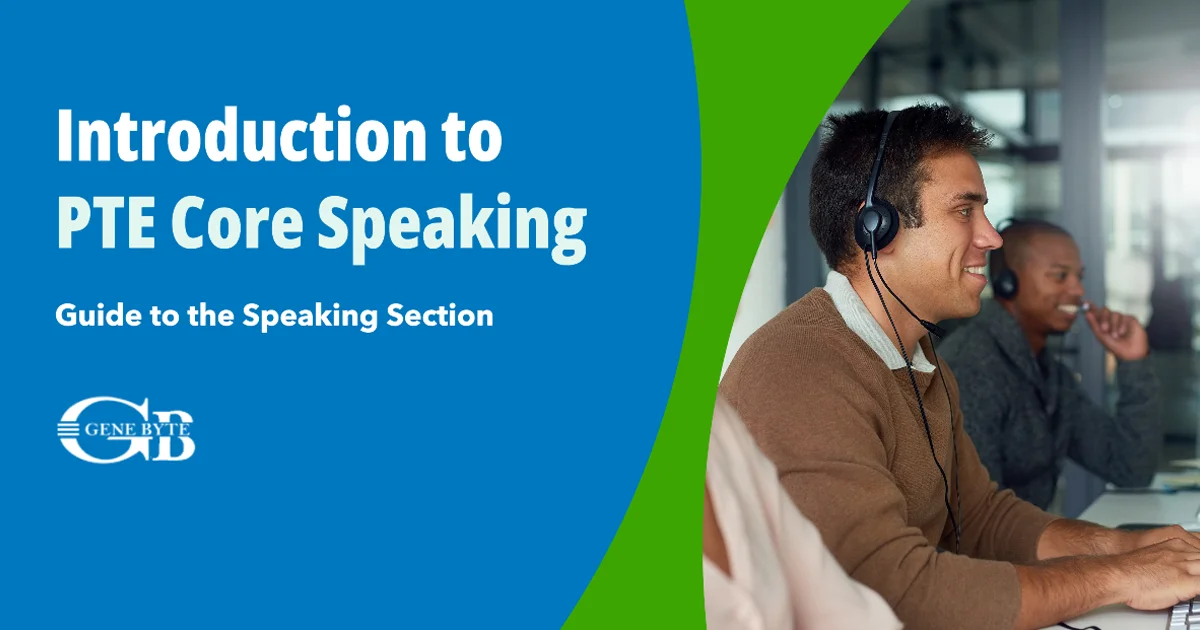Speaking Section has integrated scoring, which means Speaking module contributes marks to Reading and Listening section as well. However, you do not get marks from any other module to Speaking module. Means Speaking section has high importance, as it is potentially worth a lot more marks than 90 of Speaking Skill.
In the dynamic landscape of PTE Core preparation, the Speaking section emerges as a critical area that can significantly impact a student's overall performance and english language proficiency. In comparison to PTE Academic, it is more of a general training test. As a dedicated professional at Genebyte, my journey has been centered on leveraging our innovative SaaS solutions to redefine how coaching institutes approach PTE, IELTS, and CELPIP preparation. It's not just about enhancing revenue streams for these institutes but also about transforming the pedagogical approach to standardized English language test prep.
Embarking on a deeper exploration of the PTE Core Speaking section, we recognize its pivotal role in not just gauging a candidate's verbal proficiency but also its intertwined significance with reading and listening skills. This section, comprising 24 to 27 minutes of the test duration and encapsulating 25 to 31 questions across five distinct task types, is designed to mirror real-life English usage rather than academic English. Each task within the Speaking section—ranging from 'Read Aloud' to 'Answer Short Questions'—demands a nuanced understanding of English that goes beyond mere fluency. It's about conveying ideas clearly, engaging in thoughtful communication, and adapting language use to different contexts. This module for this test is not much different than the speaking module for PTE Academic test. The main difference is that the Retell Lecture question type has been replaced with Respond to a Situation and you get a new evaluation criterion by the name of Appropriacy.
The objective of our discussion is not to delve into preparation strategies but to illuminate the structure, scoring intricacies, and the overarching importance of the Speaking section within the PTE Core test. Our aim is to empower teachers with a comprehensive understanding of this section's dynamics, enabling them to tailor their instructional methodologies more effectively. By doing so, we not only elevate the teaching standards within our partner institutes but also ensure that students are better equipped to tackle the challenges of PTE Speaking in the PTE Core Speaking section, ultimately leading to improved outcomes.
As we navigate through the intricacies of the Speaking section, it's crucial for educators to appreciate the integrated scoring system that values not just the accuracy of responses but also their relevance and fluency. This holistic approach underscores the need for a teaching paradigm that emphasizes comprehensive language skills to achieve a great PTE score! This also helps in fostering an environment where a test taker can thrive in all facets of their English language journey.

Introduction to PTE Core Speaking Section
Overview of PTE Core as a Computer-based English Proficiency Test
Genebyte's B2B SaaS solution provides a comprehensive framework for coaching institutes, focusing on the critical components of the PTE Core Speaking section, a pivotal element of the computer-based English proficiency test. PTE Core, recognized for its alignment with IRCC's language proficiency requirements, challenges candidates across four distinct sections: Speaking, Writing, Reading, and Listening. These sections are meticulously designed to evaluate a candidate's English language skills in a variety of contexts, from everyday conversations to workplace communication.
Importance of the Speaking Section in PTE Core
The Speaking section, in particular, holds significant weight in the overall assessment, contributing not only to the Speaking score but also impacting the scores of Reading and Listening sections through integrated scoring. This unique aspect underscores the section's complexity and the strategic importance of mastering it. With a total time allocation of 18-20 minutes, candidates are tested across 26 to 33 questions, covering five diverse task types, each with its distinct scoring criteria and challenges.
Genebyte's Role in Enhancing Speaking Skills
Genebyte's solution empowers coaching institutes with advanced tools and resources to tackle the Speaking section effectively. Through AI-driven analysis and comprehensive practice materials, the platform offers immediate feedback on pronunciation, fluency, and the overall delivery of responses. This immediate, actionable insight allows candidates to refine their speaking abilities in real-time, focusing on areas that directly influence their scores.
By incorporating strategies such as template use for subjective-style answers and offering in-depth insights into the scoring algorithm, Genebyte's platform demystifies the preparation process. It enables students to practice with materials that mirror the actual test environment, including repeated question items from previous exams. This approach not only familiarizes students with the test format but also equips them with the confidence to tackle the Speaking section with a higher level of preparedness.
In the context of the Speaking section's significant role in the PTE Core exam, Genebyte's B2B SaaS solution stands as a vital ally for coaching institutes. It enhances their teaching capabilities, enabling them to deliver targeted, effective preparation strategies that cater to the nuanced demands of this critical section. Through this partnership, institutes can significantly improve their students' chances of achieving their desired scores, thereby elevating their reputation and success rates in competitive English proficiency testing landscapes.

Structure of the Speaking Section in PTE Core: A Deep Dive into Read Aloud
Emphasizing the Speaking Module's Composition
The Speaking section in PTE Core, essential for assessing English language fluency, spans approximately 18-20 minutes and comprises 26 to 33 questions across five distinct task types. It starts with an unscored personal introduction. This segment not only tests the examinees' ability to articulate thoughts in English but also influences scores in the Reading and Listening sections, underscoring its significance in the overall assessment.
Focused Examination: Read Aloud Task
The Read Aloud task, a critical component of the Speaking module, intertwines Reading and Speaking skills, presenting examinees with texts up to 60 words long. The task demands careful phrasing and intonation, reflecting the text's overall meaning. Preparation time and reading duration each span 30-40 seconds, challenging test takers to manage their articulation and pacing efficiently.
Scoring Dynamics and Strategies
Scoring for Read Aloud is multifaceted, with each of the 6 to 7 items scored on Content, Oral Fluency, and Pronunciation, each aspect weighted equally and contributing to a high importance rating within the Speaking section. Success in this task not only boosts the Speaking score but also impacts the Reading score, demonstrating the task's integrated scoring nature.
Practical Insights for Educators
For educators at PTE Core preparation institutes, understanding the Read Aloud task's intricacies is paramount. The task's dual focus on fluency and accuracy offers a unique opportunity to enhance learners' pronunciation and pacing. Emphasizing the need for clear articulation and natural speech rhythm can significantly influence students' performance, not just in Speaking but across other sections due to the integrated scoring system. And that is how your PTE score can receive a substantial bump!

Structure of the Speaking Section in PTE Core: Zooming In on Repeat Sentence
Unveiling the Repeat Sentence Task
Within the Speaking module of the PTE Core, the Repeat Sentence task stands as a testament to the test's comprehensive evaluation of a candidate's listening and speaking abilities. Tasked with repeating a sentence after hearing it only once, this task bridges the gap between auditory comprehension and verbal reproduction, challenging students to showcase their proficiency in both domains.
Task Dynamics
The Repeat Sentence task presents sentences ranging from 3 to 9 seconds in length, encapsulating 9 to 18 words, which are typically within the 11 to 15 words range. The immediate challenge for test takers is the absence of preparation time, demanding a high level of concentration and memory recall to accurately reproduce the sentence heard.
Scoring Insights
Scoring for Repeat Sentence is divided among content, oral fluency, and pronunciation, with each aspect critically evaluated. The task holds a high importance rating within the Speaking section due to its unique contribution to both the Speaking and Listening scores, emphasizing its role in the integrated scoring system of the PTE Core. This task, with its 10 to 12 occurrences within the exam, requires not just a grasp of the language but an ability to process and articulate information swiftly and accurately. Just like the Read Alouds, these can also give your PTE score a substantial increase.

Structure of the Speaking Section in PTE Core: Focusing on Describe Image
Exploring the Describe Image Task
Within the PTE Core Speaking section, the Describe Image task uniquely assesses a candidate's ability to quickly organize thoughts and articulate them coherently and concisely. This task requires a test taker to examine an image and describe its content within a limited timeframe, testing their spontaneous speaking skills and their ability to identify key elements and trends depicted visually.
Task Composition and Execution
The Describe Image task presents a variety of images, from graphs and charts to photographs and illustrations, each demanding a different approach to description. Test takers are given 25 seconds to prepare their response upon viewing the image, followed by 40 seconds to articulate their description. This structure challenges the examinee to not only grasp the image's details swiftly but also to prioritize information effectively within the speaking duration.
Scoring Parameters
Scoring for this task is based on the clarity of the description, the relevance of the information provided, and the fluency and pronunciation of the spoken response. With 3 to 4 images typically presented in the exam, each response is critical to maximizing the overall speaking score. PTE score of this task emphasizes the need for structured preparation and practice in delivering concise, coherent image descriptions.

Structure of the Speaking Section in PTE Core: Navigating Respond to a Situation
Deciphering Respond to a Situation
In the PTE Core Speaking section, the Respond to a Situation task is designed to assess a test taker's ability to understand and articulate a response to a given scenario. This task simulates real-life situations, requiring candidates to showcase their proficiency in adapting their language to various contexts. It's a critical component that evaluates both listening and speaking skills, reflecting the practical application of English in everyday life.
Task Mechanics
Participants are presented with a situation described in text and audio, after which they are given 20 seconds to prepare their response. The response duration is 40 seconds, during which the examinee must articulate a clear, coherent answer that effectively addresses the situation presented. This task tests the ability to process information quickly, organize thoughts, and respond appropriately within a constrained timeframe.
Importance and Scoring
Respond to a Situation carries a medium importance rating within the Speaking section, with 2 to 4 items typically presented in the exam. Scoring focuses on the relevancy and coherence of the response, oral fluency, and pronunciation. This task uniquely contributes to both the Speaking and Listening scores, highlighting its role in the integrated assessment model of the PTE Core. Effective responses require not just linguistic accuracy but also the ability to engage with the scenario in a meaningful way.
Tailoring Instruction for Success
By leveraging Genebyte's technology, educators can offer targeted strategies to improve students' abilities to think on their feet, organize their responses effectively, and articulate their thoughts with clarity and confidence. This not only enhances their performance in the Respond to a Situation task but also builds foundational skills that are valuable across all sections of the PTE Core and beyond.

Structure of the Speaking Section in PTE Core: Unraveling Answer Short Question
Unpacking Answer Short Question Task
In the PTE Core Speaking section, the Answer Short Question task is a concise yet significant challenge that tests a candidate's ability to quickly comprehend a spoken question and respond accurately. This task assesses not just the test taker's listening skills but also their ability to retrieve relevant information and articulate a precise answer. It's a direct measure of a student's functional language use in a conversational context, encapsulating the practicality of language proficiency in real-world scenarios.
Task Dynamics
Each Answer Short Question prompt is designed to elicit a brief, usually one-word or a few words, response. Candidates listen to a question, which could range from general knowledge to specific academic content, and then have a short span—typically a few seconds—to formulate and provide their answer. This task underscores the importance of clarity and brevity in communication, challenging students to distill their response to its essence.
Importance and Scoring
Given its straightforward nature, the Answer Short Question task is marked on a correct or incorrect basis, differing from other tasks within the Speaking section that may involve more nuanced scoring criteria. Despite its seemingly simple format, this task plays a crucial role in evaluating a candidate's listening comprehension and spontaneous verbal response capabilities. With 5 to 6 questions of this type appearing in the exam, each correct answer directly contributes to the overall Speaking and Listening scores, reinforcing the integrated scoring system of the PTE Core.

Scoring Criteria and Integration in the Speaking Section of PTE Core
In the context of PTE Core, a vital element for teachers to understand and convey to their students is the scoring criteria and its integrated nature. The Speaking section, a fundamental component of PTE Core, employs a nuanced scoring algorithm that assesses a wide array of skills. This complexity is essential for teachers to grasp to effectively prepare their students.
Integrated Scoring: A Comprehensive Assessment
Unlike traditional tests where each section is evaluated in isolation, PTE Core introduces an integrated scoring system. This means the Speaking section not only contributes to the overall Speaking score but also impacts the Reading and Listening scores. Means you have to focus more than just spoken English as it has a huge impact on the possible PTE scores of your Core test. Such integration underscores the importance of the Speaking section, as its influence extends beyond its immediate boundaries. For instance, tasks like Repeat Sentence and Describe Image assess not just the ability to speak but also to listen and understand, thereby affecting scores across multiple sections.
The Complexity of the Scoring Algorithm
The scoring algorithm in the Speaking section is far from straightforward. It takes into account several factors, including task difficulty, response accuracy, content relevance, fluency, and even the word limits of the given answers. This algorithmic approach ensures a balanced evaluation of a candidate's language proficiency, emphasizing the ability to use English in practical, real-world situations. For example, in tasks such as Answer Short Question, the scoring is binary—correct or incorrect. However, for more subjective tasks like Describe Image or Respond to a Situation, the scoring becomes more granular, considering the nuances of the response.
Emphasizing Fluency and Pronunciation
A significant part of the Speaking score is derived from fluency and pronunciation, highlighting the need for clear, understandable speech without undue pauses or hesitations. Teachers should encourage students to practice speaking at a natural pace, focusing on clarity and smoothness of delivery. Pronunciation, too, is critical, as it directly affects the listener's ability to comprehend the spoken word. Regional accents are acceptable as long as they do not hinder understanding.
Practical Implications for Teachers
Understanding these scoring dynamics is crucial for teachers. It allows them to tailor their instruction, focusing on high-impact areas that can significantly boost a student's score. For instance, knowing that the Speaking section influences Reading and Listening scores, teachers might integrate exercises that enhance not just speaking skills but also listening comprehension and the ability to quickly and accurately process spoken information and develop overall language skills.

The Significance of High-Scoring Task Types in the PTE Core Speaking Section
When preparing for the PTE Core, understanding the significance of high-scoring task types in the Speaking section is crucial for both teachers and students. This knowledge enables educators to strategize their teaching efforts more effectively, ensuring that their students can maximize their score potential. In the Speaking section, certain tasks carry more weight and, therefore, offer a greater opportunity to boost overall scores.
High-Importance Tasks within the Speaking Section
The Speaking section, a pivotal part of the PTE Core, assesses a candidate's ability to speak English fluently and coherently. It consists of several task types, each contributing differently to the final score. Among these, the Read Aloud and Repeat Sentence tasks stand out for their high scoring potential.
- Read Aloud: This task assesses both reading and speaking skills by requiring test-takers to read a text aloud. It is considered high-importance due to its substantial contribution to the speaking score. The task evaluates a candidate's ability to pronounce words correctly, maintain fluid speech, and convey the text's meaning through appropriate intonation and pacing.
- Repeat Sentence: Another critical task, the Repeat Sentence, challenges students to listen to a sentence and then repeat it verbatim. It tests listening and speaking skills simultaneously, emphasizing memory, attention to detail, and the ability to replicate the sentence's structure, pronunciation, and intonation accurately.
Template Usage for Subjective Tasks
For subjective-style tasks like Describe Image and Respond to a Situation, templates play a pivotal role in structuring responses effectively. These templates provide a scaffold that helps candidates organize their thoughts and present them coherently. By utilizing templates, candidates can ensure that their responses are comprehensive, covering all necessary points within the limited time frame. Genebyte's platform offers a range of templates designed specifically for these tasks, enabling candidates to enhance their scores through structured and focused responses.
Prioritizing Study Efforts Based on Task Significance
For coaching institutes utilizing Genebyte's B2B SaaS solutions, focusing on these high-importance tasks during preparation can lead to significant score improvements for students. Our platform provides targeted practice for these tasks, incorporating real-time feedback mechanisms like pitch and pace meters to refine speaking skills further. This approach allows students to practice in a simulated test environment, enhancing their readiness for the actual exam.
Here's a concise overview of the tasks' scoring potential in the Speaking section:
| Task Type | Speaking Score Contribution | Importance Level |
|---|---|---|
| Read Aloud | High | High |
| Repeat Sentence | High | High |
| Describe Image | Medium | Medium |
| Respond to a Situation | Medium | Medium |
| Answer Short Question | Low | Low |
Given the diverse nature of tasks within the Speaking section, it is imperative to adopt a strategic approach to preparation. Here are some recommendations for prioritizing study efforts:
- Focus on High-Scoring Tasks: Allocate more preparation time to Read Aloud and Repeat Sentence tasks. Practice with Genebyte's extensive question bank, which mirrors actual exam content, to become familiar with the types of texts and sentences you will encounter.
- Utilize Templates for Subjective Responses: Engage with Genebyte's customized templates for Describe Image and Respond to a Situation. Practice incorporating key phrases and structures from these templates into your responses to improve fluency and organization.
- Balanced Preparation Across Task Types: While prioritizing high-scoring tasks, do not neglect other areas of the Speaking section. A well-rounded preparation strategy ensures that you are equipped to handle all task types effectively.
- Regular Practice and Feedback: Use Genebyte's AI-based evaluation tools for immediate feedback on your practice attempts. This will help you identify areas for improvement and track your progress over time.
By integrating such insights into their curriculum, institutes can ensure that their students are spending their preparation time wisely, focusing on areas that will yield the highest return in terms of score improvement.

Repetition and Memorization of Material: A Key to Mastery in Speaking Section
Unveiling the Power of Repetition
At Genebyte, we emphasize the transformative role of repetition and memorization in mastering the Speaking section of the PTE Core English test. Our innovative B2B SaaS solution equips coaching institutes with the tools necessary to harness this power effectively.
The Merits of Memorizing Repeated Material
- Familiarity Breeds Confidence: Regular exposure to repeated material from past exams diminishes exam anxiety, fostering a sense of familiarity and confidence among students.
- Precision in Delivery: Memorizing high-frequency questions and answers enables students to refine their pronunciation, pacing, and fluency, leading to improved performance in the Speaking section.
- Strategic Preparedness: Understanding the patterns and types of questions that recur in exams allows students to prepare more strategically, focusing their efforts where it counts the most.
Practical Tips for Efficient Memorization
- Daily Practice: Encourage students to dedicate a portion of their study time to memorizing phrases and vocabulary that commonly appear in the Speaking section.
- Leverage Technology: Utilize our SaaS platform's extensive database of repeated questions for targeted practice, ensuring students are familiar with the types of tasks they'll encounter.
- Mock Tests: Regularly engage students with mock tests that mirror the actual exam conditions, reinforcing their memorization through practical application.
- Visualization Techniques: Teach students to use visualization and association techniques to better retain the structure and content of responses.
- Group Study: Promote group study sessions among students, allowing them to quiz each other on material and share mnemonic strategies.

Actionable Tips on PTE Core Speaking for Educators:
- Utilize Real-time Feedback: Our software provides immediate feedback on students' Speaking performances, pinpointing areas for improvement.
- Adopt Adaptive Learning: Tailor the learning experience to meet individual student needs, leveraging our AI-driven insights.
- Engage with Interactive Content: Use our platform's interactive Speaking simulations to create a dynamic learning environment that mimics the PTE Core exam closely.
Recommendations for Institutes
- Integrate Comprehensive Analytics: Harness the power of our data analytics tools to track student progress comprehensively.
- Leverage Cloud-based Flexibility: With our cloud computing infrastructure, access the platform anywhere, ensuring that your teaching methodologies are as flexible as your students' learning paths.
- Customize to Your Brand: Take advantage of our white-label solution to present this innovative platform under your institute's brand, enhancing your market presence.
Genebyte's Edge in Speaking Mastery
Our platform is designed to make repetition and memorization an integral part of PTE Core preparation. Here's how we stand out:
- Tailored Content: Access to a vast repository of past exam questions and answers, updated regularly to reflect the most current exam trends.
- Real-Time Feedback: Instant feedback on pronunciation, pace, and fluency, enabling students to adjust their speaking in real time.
- Personalized Learning Paths: Customizable practice sessions that focus on the student's weak areas, ensuring efficient use of study time.
- Community Learning: A feature that allows students to learn collectively, sharing insights and strategies for memorizing and applying knowledge effectively.
In the journey of PTE Core preparation, the Speaking section presents unique challenges and opportunities for students and teachers alike. Following the Speaking part of the exam, it is time to delve into the Writing Section. Genebyte's B2B SaaS solutions equip coaching institutes with the necessary tools to navigate these challenges successfully. Our platform's emphasis on real-time feedback, adaptive learning, and interactive content ensures that students are not just prepared but poised to excel in the PTE Core exam.
By adopting Genebyte's solutions, institutes can offer a personalized, efficient, and comprehensive learning experience, setting their students on the path to achieving their desired scores. Our commitment to enhancing the teaching and learning experience through innovative technology is unwavering, and we invite you to join us in this educational revolution.
For a deeper dive into how Genebyte can transform your institute's approach to PTE Core preparation, we encourage you to contact us for a demo. Together, let's redefine success in language proficiency exams.
Frequently Asked Questions
This involves assessing English speaking skills through tasks like Read Aloud, Repeat Sentence, Describe Image, Respond to a Situation, and Answer Short Question, crucial for everyday and professional communication.
Yes, using templates for tasks like Describe Image and Respond to a Situation can significantly improve scores by providing a structured response format.
The Speaking section tests English speaking skills through various tasks, contributing significantly to overall language proficiency assessment.
It comprises five main tasks, each designed to evaluate different aspects of speaking proficiency.
Tasks like Read Aloud and Repeat Sentence, when prepared with repeated material and strategies, often yield higher scores due to familiarity and practice.
There are five distinct question types, each assessing varied speaking skills.
Repetition and memorization of material can greatly enhance performance, especially for question types with repeated content.
Integrated scoring means Speaking tasks also impact scores in Reading and Listening, highlighting its importance for overall performance.
Strategies include practicing with templates, focusing on fluency and pronunciation, and regular review of repeated question material.
Scores are calculated using a complex algorithm considering task difficulty, response accuracy, fluency, and pronunciation.
No, it's conducted via computer, assessing speaking skills through microphone responses to on-screen prompts.
It involves an algorithmic analysis of fluency, pronunciation, and content relevance, with each task type contributing differently to the total speaking score.
